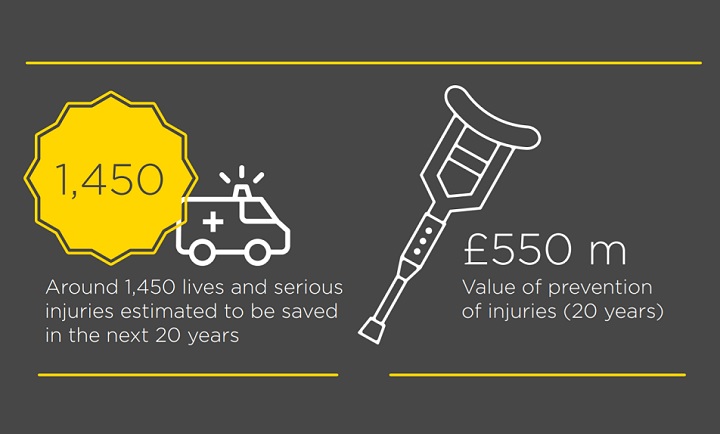
A leading road safety charity and one of the UK’s largest motor insurers have issued a joint call for the Government to commit to a new Safer Roads Fund as a ‘major investment in the country’s road network’.
The call from the Road Safety Foundation* and Ageas came on the day Boris Johnson announced £900m of funding for ‘shovel ready’ local projects in England this year and in 2021.
The Safer Roads Fund was established in November 2016 to treat the highest risk local A road sections in England with remedial road safety engineering interventions. Through the Fund the DfT committed £100m to finance 48 schemes to be delivered in the four financial years 2017/18 to 2020/21.
The Road Safety Foundation says between them these schemes will prevent around 1,450 fatal and serious injuries over the next 20 years. The value of prevention of these deaths and injuries is estimated at £550m compared with the whole life cost of treatments of £125m. The ‘benefit to cost’ ratio is 4.4, meaning that for every £1 invested, £4.40 is returned in terms of societal benefit.
Dr Suzy Charman, executive director of the Road Safety Foundation, said: “We have identified a number of road sections that are high priority for immediate investment to save lives.
“These proposals are all as good as ‘shovel ready’ as they are fast to plan and implement. Local authorities badly need funding from central government to invest in such schemes.
“We know that such investments have high societal returns – often as much as £5 for every £1 spent, competing well with other major infrastructure projects.”
*The Road Safety Foundation is a UK charity advocating road casualty reduction through simultaneous action on all three components of the safe road system: roads, vehicles and behaviour.
The issues with this seductive request are twofold:
1) It’s not the roads that are high risk but we, the drivers that use those roads. We need interventions that change our behaviour, permanently, not just at a particular place.
2)The ‘highest risk roads’ are actually in urban areas, with 2/3 of all casualties (and just under 60% of KSIs). While rural roads have a bigger share of fatalities – 2/3 of road deaths – that is because speeds at which we drive are too high; the roads themselves are not intrinsically riskier.
The proposal to ‘tackle the highest risk roads’ is a fool’s errand, if it applies to the rural A roads as described in the document.
Let’s examine the facts.
First, we assume that the projected savings for the £100m invested are actually achieved. The aim is to reduce the numbers killed or seriously injured on our roads each year by 72 (1,450 over 20 years). Based on Government casualty cost estimates, the financial savings are £550m over 20 years, giving an impressive 27.5% annual return on investment, which ‘pays back’ in under 4 years.
Now compare how many serious injuries and fatalities might be saved if the same £100m were invested in 20mph schemes.
Here we assume that the government does NOT change the default speed on urban roads – doing so would reduce 20mph implementation costs substantially – and the typical cost remains at £5 per person. £100m would cover about 20m people – say 1/3 of the UK population.
In 2018, 12,000 people were killed or seriously injured on urban roads with a 30mph speed limit. Even excluding A roads, some of which are likely to be suitable for 20mph, that leaves 7,500 KSIs on minor urban roads, all of which could be 20mph. Applying the £100m to 1/3 of those roads gives a potential casualty population of (say) 2,500.
20mph typically reduces casualties by around 20% (Bristol, Brighton, Edinburgh etc), but we’ll be conservative and say 15% reduction. This equate to 375 KSIs saved by implementing 20mph on 1/3 of urban non-A roads – 5x the number achieved on “the highest risk roads”.
Mass changes to urban and village roads provide 5 times the “bangs per buck” of engineering changes on selected rural roads.
Adrian Berendt, Tunbridge Wells
+3